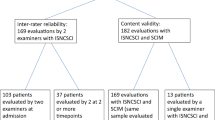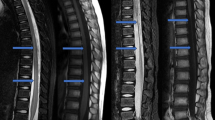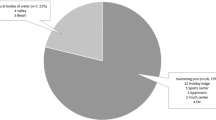Abstract
Study design:
Retrospective observational study.
Objectives:
The objective of this study was to determine the rehabilitation potential and the extent to which it is realized in a cohort of spinal cord injury patients using the Spinal Cord Injury-Ability Realization Measurement Index (SCI-ARMI) and to study the clinical factors that influence this realization.
Setting:
Two spinal units in Italy.
Methods:
Consecutive patients were assessed at the end of an in-patient rehabilitation program using the Spinal Cord Independence Measure and the International Standards for Neurological Classification of Spinal Cord Injury. On the basis of these data and of the age and gender of the patients, we calculated the SCI-ARMI score. Regression analyses were performed to study the relationship between clinical factors and the extent to which rehabilitation potential is realized.
Results:
We examined the data for 306 patients. Most patients were discharged without having reached their rehabilitation potential, with an SCI-ARMI score <80%. SCI-ARMI scores at discharge were positively influenced by etiology and the lesion level and correlated negatively with lesion severity and the presence of complications during rehabilitation.
Conclusion:
The SCI-ARMI is an effective tool that can be used to measure the achievement of rehabilitation potential in SCI patients and to identify groups of patients who are at risk of not meeting their rehabilitative potential.
Similar content being viewed by others
Log in or create a free account to read this content
Gain free access to this article, as well as selected content from this journal and more on nature.com
or
References
Catz A, Greenberg E, Itzkovich M, Bluvshtein V, Ronen J, Gelernter I . A new instrument for outcome assessment in rehabilitation medicine: Spinal Cord Injury Ability Realisation Measurement Index (SCI-ARMI). Arch Phys Med Rehabil 2004; 85: 399–404.
Aidinoff E, Benjamini Y, Galili T, Polliack T, Front L, Bluvshtein V et al. Non-linear formulas for the spinal cord injury ability realisation measurement index (SCI-ARMI). Spinal Cord 2012; 50: 324–327.
Catz A, Itzkovich M, Tesio L, Biering-Sorensen F, Weeks C, Laramee MT et al. A multi-center international study on the Spinal Cord Independence Measure, version III: Rasch psychometric validation. Spinal Cord 2007; 45: 275–291.
Scivoletto G, Glass C, Anderson KD, Galili T, Benjamin Y, Front L et al. An international age and gender controlled model for the spinal cord injury ability realization measurement index (SCI-ARMI). Neurorehabil Neural Rep 2015; 29: 25–32.
Scivoletto G, Farchi S, Laurenza L, Tamburella F, Molinari M . Impact of polytrauma on functional and neurological outcomes of patients with spinal cord injury. Scand J Trauma Resus Emerg Med 2013; 21: 42.
Pagliacci MC, Celani MG, Zampolini M, Spizzichino L, Franceschini M, Baratta S et al. Gruppo Italiano Studio Epidemiologico Mielolesioni: Spinal cord lesion management in Italy: a 2-year survey. Spinal Cord 2003; 41: 620–628.
American Spinal Injury Association. International Standards for Neurological Classifications of Spinal Cord Injury (Revised). American Spinal Injury Association: Chicago, IL, USA,. 2000, pp 1–23.
Wilson JR, Grossman RG, Frankowski RF, Kiss A, Davis AM, Kulkarni AV et al. Clinical Prediction Model for long-term functional outcome after traumatic spinal cord injury based on acute clinical and imaging factors. J Neurotrauma 2012; 29: 2263–2271.
Roth E, Davidoff G, Haughton J, Ardner M . Functional assessment in spinal cord injury: a comparison of the Modified Barthel Index and the 'adapted' Functional Independence Measure. Clin Rehabil 1990; 4: 277–285.
Grey N, Kennedy P . The Functional Independence Measure: a comparative study of clinician and self ratings. Paraplegia 1993; 31: 457–461.
McDowell I, Newell C . Measuring Health: A Guide to Rating Scales and Questionnaires. Oxford University Press: New York, NY, USA,. 1996, pp 47–121.
Guttmann L . Spinal Cord Injuries, Comprehensive Management and Research. Blackwell Scientific: Oxford, UK,. 1973, pp 639–645.
Burns AS, Ditunno JF . Establishing and maximizing functional outcomes after spinal cord injury: a review of current and future directions in rehabilitation management. Spine 2001; 26: S137–S145.
Roth EJ, Heinemann AW, Lovell LL, Harvey RL, McGuire JR, Diaz S . Impairment and disability: their relation during stroke rehabilitation. Arch Phys Med Rehabil 1998; 79: 329–335.
Scivoletto G, Farchi S, Laurenza L, Molinari M . Traumatic and non-traumatic spinal cord lesions: an Italian comparison of neurological and functional outcomes. Spinal Cord 2011; 49: 391–396.
McKinley WO, Seel RT, Gadi RK, Tewksbury MA . Nontraumatic vs. traumatic spinal cord injury: a rehabilitation outcome comparison. Am J Phys Med Rehab 2001; 80: 693–699.
Ones K, Yilmaz E, Beydogan A, Gultekin O, Caglar N . Comparison of functional results in non-traumatic and traumatic spinal cord injury. Disabil Rehabil 2007; 29: 1185–1191.
Gupta A, Taly AB, Srivastava A, Vishal S, Murali T . Traumatic vs non-traumatic spinal cord lesions: comparison of neurological and functional outcome after inpatient rehabilitation. Spinal Cord 2008; 46: 482–487.
Steeves JD, Kramer JK, Fawcett JW, Cragg J, Lammertse DP, Blight AR et alEMSCI Study Group. Extent of spontaneous motor recovery after traumatic cervical sensorimotor complete spinal cord injury. Spinal Cord 2011; 49: 257–265.
Kramer JL, Lammertse DP, Schubert M, Curt A, Steeves JD . Relationship between motor recovery and independence after sensorimotor-complete cervical spinal cord injury. Neurorehabil Neural Rep 2012; 26: 1064–1071.
Putz C, Schuld C, Gantz S, Grieser T, Akbar M, Moradi B et al. The effect of polytrauma as a possible confounder in the outcome of monotraumatic vs polytraumatic paraplegic patients: a clinical cohort study. Spinal Cord 2011; 49: 721–727.
Wang H, Niewczyk P, Divita M, Camicia M, Appelman J, Mix J et al. Impact of pressure ulcers on outcomes in inpatient rehabilitation facilities. Am J Phys Med Rehabil 2014; 93: 207–216.
New PW, Rawicki HB, Bailey MJ . Nontraumatic spinal cord injury rehabilitation: pressure ulcer patterns, prediction, and impact. Arch Phys Med Rehabil. 2004; 85: 87–93.
Author information
Authors and Affiliations
Corresponding author
Ethics declarations
Competing interests
The authors declare no conflict of interest.
Rights and permissions
About this article
Cite this article
Scivoletto, G., Bonavita, J., Torre, M. et al. Observational study of the effectiveness of spinal cord injury rehabilitation using the Spinal Cord Injury-Ability Realization Measurement Index. Spinal Cord 54, 467–472 (2016). https://doi.org/10.1038/sc.2015.153
Received:
Revised:
Accepted:
Published:
Issue date:
DOI: https://doi.org/10.1038/sc.2015.153



